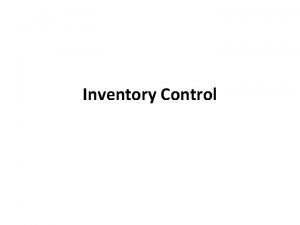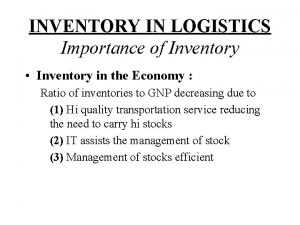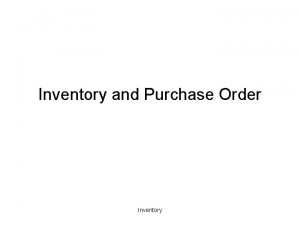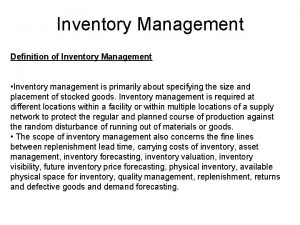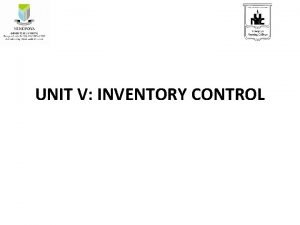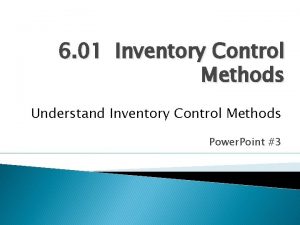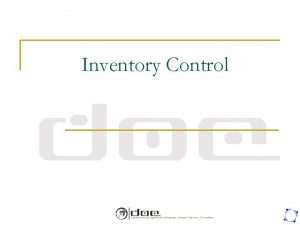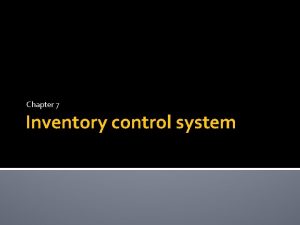Inventory Control Chapter 7 Inventory Control Involves the

















- Slides: 17

Inventory Control Chapter 7

Inventory Control Involves the procurement, care and disposition of materials. There are three kinds of inventory that are of concern to managers: �Raw materials �In-process or semi-finished goods �Finished goods

If a manager effectively controls these three types of inventory, capital can be released that may be tied up in Unnecessary inventory • Production control can be improved • Can protect against obsolescence deterioration and/or theft •

Advantages of inventory control Helps balance the stock as to value • size • color • Style & • price line in proportion to demand or sales trends • �Help plan the winners as well as move slow sellers

�Helps secure the best rate of stock turnover for each item �Helps reduce expenses and markdowns �Helps maintain a business reputation for always having new, fresh merchandise in wanted sizes and colors

Inventory Control Systems �Three major approaches can be used for inventory control in any type and size of operation The Eyeball System • Reserve Stock (or Brown Bag) System • Perpetual Inventory Systems • � The actual system selected will depend upon the type of operation and the amount of goods.

The Eyeball System �This is the standard inventory control system for the vast majority of small retail and many small manufacturing operations and is very simple in application. �The key manager stands in the middle of the store or manufacturing area and looks around. If he or she happens to notice that some items are out of stock, they are reordered.

� In retailing, the difficulty with the eyeball system is that a particularly good item may be out of stock for some time before anyone notices. �Throughout the time it is out of stock, sales are being lost on it. Similarly, in a small manufacturing operation, low stocks of some particularly critical item may not be noticed until there are none left. Then production suffers until the supply of that part can be replenished.

Reserve Stock (or Brown Bag) System � This approach is much more systematic than the eyeball system. � It involves keeping a reserve stock of items aside, often literally in a brown bag placed at the rear of the stock bin or storage area. � When the last unit of open inventory is used, the brown bag of reserve stock is opened and the new supplies it contains are placed in the bin as open stock. � At this time, a reorder is immediately placed. � If the reserve stock quantity has been calculated properly, the new shipment should arrive just as the last of the reserve stock is being used.

Calculation of Proper Reserve Stock Quantity In order to calculate the proper reserve stock quantity, it is necessary to know I. the rate of product usage II. the order cycle delivery time � Thus, if the rate of product units sold is 100 units per week and the order cycle delivery time is two weeks, the appropriate reserve stock would consist of 200 units (I 00 u x 2 w). � This is fine as long as the two-week cycle holds. If the order cycle is extended, the reserve stock quantities must be increased. � When the new order arrives, the reserve stock amount is packaged again and placed at the rear of the storage area.

�This is a very simple system to operate and one that is highly effective for virtually any type of organization. �The variations on the reserve stock system merely involve the management of the reserve stock itself. �Larger items may remain in inventory but be cordoned off in some way to indicate that it is the reserve stock and should trigger a reorder

Perpetual Inventory Systems � Various types of perpetual inventory systems include manual, card -oriented, and computer- operated systems. � In computer-operated systems, a programmed instruction referred to commonly as a trigger, automatically transmits an order to the appropriate vendor once supplies fall below a prescribed level. � The purpose of each of the three types of perpetual inventory approaches is totally either the unit use or the dollar use (or both) of different items and product lines. � This information will serve to help avoid stock-outs and to maintain a constant evaluation of the sales of different product lines to see where the emphasis should be placed for both selling and buying.

Stock Control � A stock control system should keep you aware of the quantity of each kind of merchandise on hand. An effective system will provide you with a guide for What When how much to buy of each style, color, size, price and brand. � It will reduce the number of lost sales resulting from being out of stock of merchandise in popular demand. � The system will also locate slow selling articles and help indicate changes in customer preferences.

A Checklist �It often provided by wholesalers, is another counting tool. �The checklist provides space to record the items carried, the selling price, cost price, and minimum quantities to be ordered of each. � It also contains a column in which to note whether the stock on hand is sufficient and when to reorder. �This is another very simple device that provides the level of information required to make knowledgeable decisions about effective inventory management

Inventory Control Records � Perpetual inventory control records are most practical for big-ticket items. With such items it is quite suitable to hand count the starting inventory, maintain a card for each item or group of items, and reduce the item count each time a unit is sold or transferred out of inventory. � Out-of-stock sheets sometimes called want sheets, notify the buyer that it is time to reorder an item. Experience with the rate of turnover of an item will help indicate the level of inventory at which the unit should be reordered to make sure that the new merchandise arrives before the stock is totally exhausted.

� Open-to-buy records help to prevent ordering more than is needed to meet demand or to stay within a budget. These records adjust your order rate to the sales rate. They provide a running account of the dollar amount that may be bought without departing significantly from the pre- established inventory levels. � Purchase order files keep track of what has been ordered and the status or expected receipt date of materials. It is convenient to maintain these files by using a copy of each purchase order that is written. � Supplier files are valuable references on suppliers and can be very helpful in negotiating price, delivery and terms

� Returned goods files provide a continuous record of merchandise that has been returned to suppliers. They should indicate amounts, dates and reasons for the returns. This information is useful in controlling debits, credits and quality Issues. � Price books maintained in alphabetical order according to supplier, provide a record of purchase prices, selling prices, markdowns, and markups. It is important to keep this record completely up to date in order to be able to access the latest price and profit information on materials purchased for resale.
 Budgetary control involves
Budgetary control involves Hát kết hợp bộ gõ cơ thể
Hát kết hợp bộ gõ cơ thể Lp html
Lp html Bổ thể
Bổ thể Tỉ lệ cơ thể trẻ em
Tỉ lệ cơ thể trẻ em Voi kéo gỗ như thế nào
Voi kéo gỗ như thế nào Tư thế worm breton
Tư thế worm breton Chúa sống lại
Chúa sống lại Các môn thể thao bắt đầu bằng từ đua
Các môn thể thao bắt đầu bằng từ đua Thế nào là hệ số cao nhất
Thế nào là hệ số cao nhất Các châu lục và đại dương trên thế giới
Các châu lục và đại dương trên thế giới Công thức tính độ biến thiên đông lượng
Công thức tính độ biến thiên đông lượng Trời xanh đây là của chúng ta thể thơ
Trời xanh đây là của chúng ta thể thơ Mật thư tọa độ 5x5
Mật thư tọa độ 5x5 101012 bằng
101012 bằng Phản ứng thế ankan
Phản ứng thế ankan Các châu lục và đại dương trên thế giới
Các châu lục và đại dương trên thế giới Thể thơ truyền thống
Thể thơ truyền thống



















